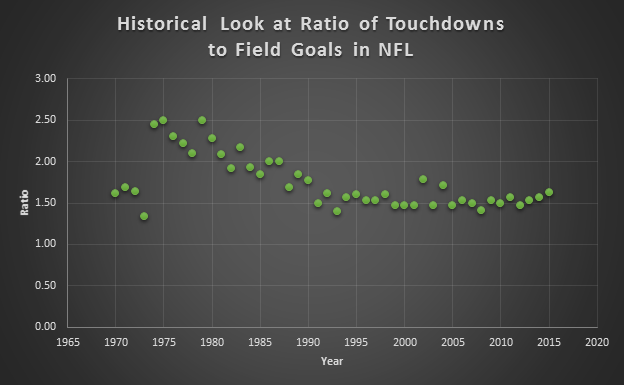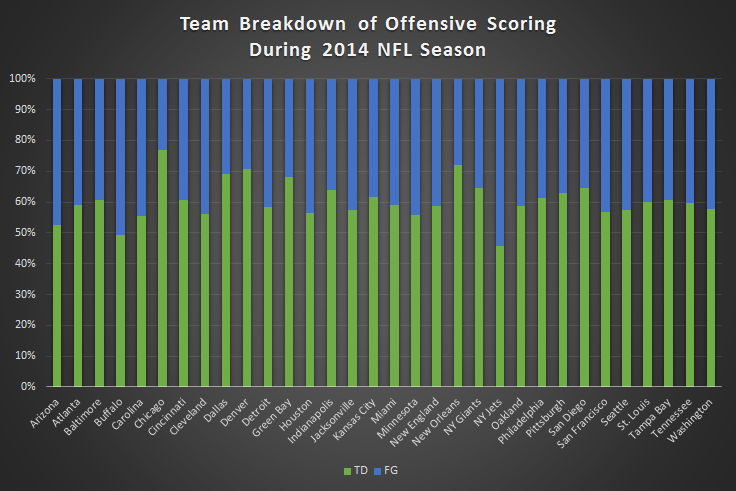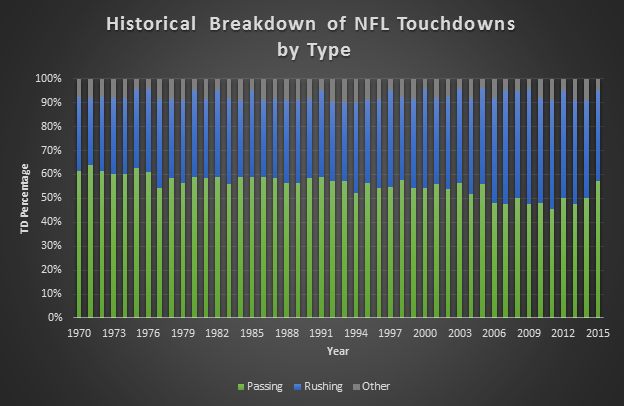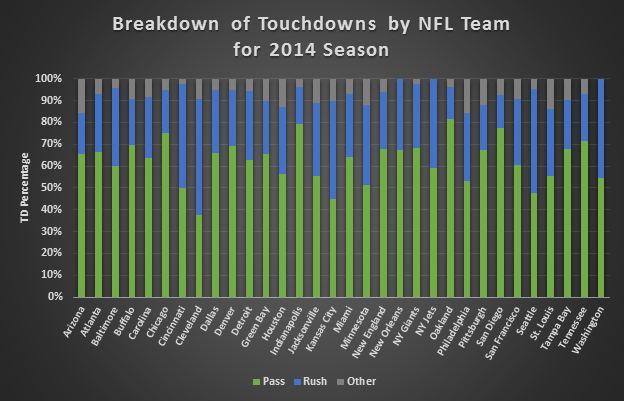Since the start of the NFL season, there have been quite a few SFTC props where we have been asked to pick an over/under on touchdowns for a given team or player. One thing I was curious about is what ratio to use for converting the projected points for each team into projected TDs during a given period of time. In this post, we will investigate the historical breakdown of scoring in NFL games since the AFL/NFL merger, which we can use to help guide us on these types of props.
Touchdown to Field Goal Ratio
The graph below illustrates the ratio of touchdowns to field goals each NFL season since 1970. The first few years post-merger, the ratio of touchdowns to field goals is around 3 to 2. Beginning around 1974, the ratio jumped to around 5 to 2. This was a result to rule changes making field goals more difficult (see 1974 NFL). As players adjusted to the changes, the NFL in 1978 introduced the 5 yard contact rule in order to further open up the passing game (see 1978 NFL). Since these changes, the ratio has slowly been falling back down toward 3 to 2 and stayed there for 20 years. However, there seems to be an upward trend again in the last few years with more rule changes greatly benefitting quarterback play and creating a passing league. Therefore, we might expect the ratio to be closer to 1.6 this season and in the next 5-10 seasons could reach 2 again.

A historical depiction of touchdown to field goals by season. Source: https://www.pro-football-reference.com/years/AFLNFL/scoring.htm
NFL Scoring Breakdown by Team
Although, it may be reasonable to use 1.6 TDs for every FG when determining the expected number of touchdowns, there is quite a bit of team to team variability. We illustrate from the 2014 season, the percentage of offensive scores that are touchdowns versus field goals by team. As expected, most teams are around 60/40 with some teams higher/lower depending heavily on the quality of their quarterback play. For example, Arizona was closer to 50/50 as they were down to their 2nd and 3rd string quarterbacks for a good portion of last season. The kicker is less important since they are plug and play whereas quarterbacks need to learn a whole playbook.

Offensive scoring breakdown for 2014 NFL season. Source: https://espn.go.com/nfl/statistics/
More on NFL Scoring Breakdown
In addition to determining how many touchdowns will be scored, there has been a lot of interest in determining how many passing or rushing touchdowns will be scored or what team or player will score a touchdown first. We know we can use between 1.5 and 2 TDs per FG to determine the amount of touchdowns expected, but the next step is to further break down how many of each type of touchdown will be scored.

A breakdown of touchdowns over the years. Source: https://www.pro-football-reference.com/years/AFLNFL/scoring.htm
Looking at the graphic above and corresponding with rules changes previously mentioned, the percentage of passing touchdowns was twice that of rushing touchdowns. The breakdown in fact used to be around 60% passing, 32% rushing, and 8% other. However, the trend from 1970 onward has been more balanced scoring offense. Again, this is beginning to change as rules changes in the last 5 years have created more of a passing league, increasing the ratio back toward 65%, 30%, 5% for the different touchdowns.
For simplicity, we typically expect that there will be about twice as many passing touchdowns as rushing touchdowns, but the team playing may dictate this as well. Below is the breakdown of touchdowns by team for the 2014 season. If we notice that a team deviates from the average by a large amount, has an injured quarterback, or has a depleted running back corps, expectations may need some adjusting.

A breakdown of touchdowns by NFL team for the 2014 season. Source: https://espn.go.com/nfl/statistics/
